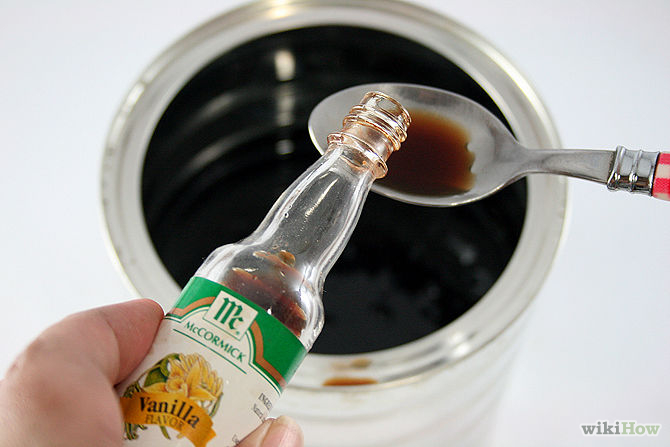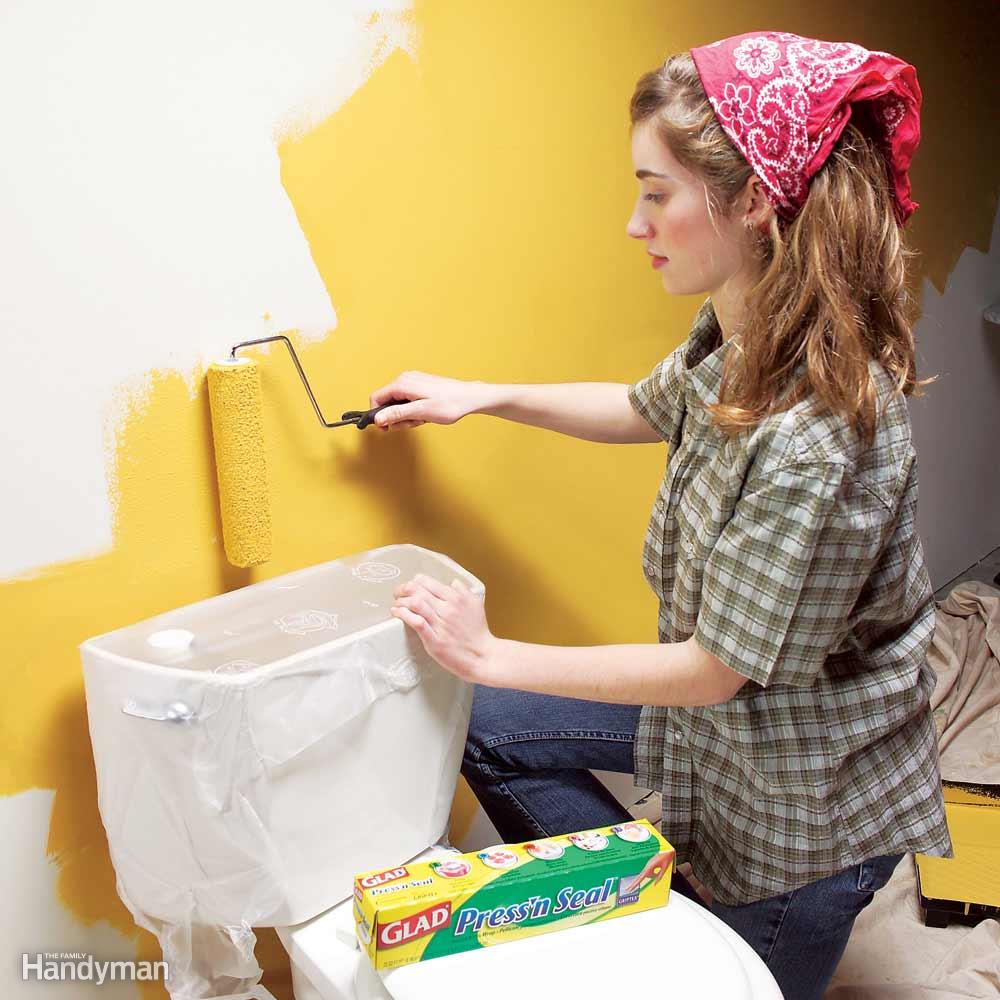Clever Tips To Make Painting Your Home Easier

Painting is one of the easiest and least expensive ways to transform a space. But it can also be a hassle, what with all that taping and prepping and cleaning up. These clever tips can make it easier. Fun, even. (That might be a stretch.)
Wrap it up
One of the most painful tasks associated with the painting is having to clean up at the end of the day. If you hate cleaning your brushes, this tip is for you. The best way to preserve your brush if you're done for the day (or the time being) but not done with the job, is to wrap it in plastic wrap and throw it in the freezer overnight. But, it does require about 15 minutes of thawing out the following day before you can begin again. We found that putting the brush in a Ziploc bag and making it as airtight as possible does a fine job of keeping the brush pliable for the next day, and you can just pick it up and go without the wait.
Line it
Paint tray liners are helpful in extending the life of your paint tray and minimizing clean up, but if you don't want to spend the money, head to your kitchen, instead. Aluminum foil or plastic wrap wrapped around your paint tray will keep it clean.
 removeandreplace.com
removeandreplace.com
Keep that foil handy
Reader's Digest notes that aluminum foil is also great when painting a door. "When you're painting a door, aluminum foil is great for wrapping doorknobs to keep paint off them. Overlap the foil onto the door when you wrap the knob, then run a sharp utility knife around the base of the knob to trim the foil. That way you can paint right up to the edge of the knob. In addition to wrapping knobs on the doors that you'll paint, wrap all the doorknobs that are along the route to where you will clean your hands and brushes."
Dust those walls
Prepping is key to a successful paint job, but if you're doing a quick cleanup of your walls before painting, you may not want to spray cleaner on them for fear that the paint won't adhere well. Use a Swiffer duster instead. Dust will cling to it and you'll have a clean surface to paint on. A dryer sheet is another good option for getting the dust off your surfaces - especially baseboards - before you begin.
Take out the smell
If you're using a VOC paint, any odor should be minor. But if you want to ensure the smell is pleasant, add some vanilla. "To neutralize the strong smell of any type of paint, add one tablespoon of vanilla extract (a natural deodorizer) per gallon. It won't affect the color of the paint," said HGTV.
 FaithTap
FaithTap
Use a quality paintbrush
You can spend about $1 on a paint brush or you can spend the equivalent of a good lunch, and the difference will be obvious when the cheaper version leaves brush marks and bristles on your wall. Get a decent brush for a better finish, and choose an angled version for cutting in. The better the brush (and paint!), the better the chance you can do without all that pesky taping.
Buy the right amount of paint from the start
"Oh, I just need one gallon," said everyone, everywhere. But how much do you really need? Knowing ahead of time will keep you from having to make a return trip to the store, and help ensure your color is consistent. Color matching is better than ever at paint stores and places like Home Depot and Lowe's. But there still might be a slight variation in the color if you have to go back to purchase more paint. Measure your space and you won't have to worry about it.
"The general rule is one gallon for every 350 square feet of surface area," said Real Simple. "All you have to do is measure walls roughly, then go to Sherwin-Williams.com and type the dimensions into the easy online paint calculator. This tool will also ask for measurements of windows, doors, and trim so it can come up with a more precise total. Whatever the number, buy an extra quart for touch-ups."
Wipe it up
Have a few drips to clean up on tile or wood floors? An alcohol wipe or wet rag will do the trick. Or, grab a cleansing facial wipe that contains alcohol. You'd be surprised how well these work.
Add a rubber band
Wrap one around your paint can so you have an easy way to wipe your paint brush and avoid drips.
Combat humidity
"Humidity means drips and slow drying, so avoid painting on a rainy day," said DIY Network. "If you must paint when it's humid, take your time - and take advantage of slow-drying paint to correct your errors before moving on to the next coat."
You can reduce the amount of humidity in your home by flipping on your air-conditioning as well as any vent and exhaust fans you have in the home, in bathrooms, kitchens, and laundry areas.
Put some holes in it
"When you pour the paint, it can go everywhere," said The Bold Abode. "It drips all over the sides and then dries hard as a rock on the edges. When that happens, not even King Kong himself could pound that lid down hard enough to close it securely." Hammering a few holes in the lip of the paint can will help the paint drain back down into the can.
Get creative with plastic bags
For awkward spaces where a drop cloth might not be the right choice, heed this tip from Family Handyman and raid your plastic bag stash. It'll keep your stuff drip-free and won't cost a thing.
 familyhandyman.com
familyhandyman.com
Want to estimate your home improvement costs before talking with a contractor? Claim your home for free with bluehammer to estimate costs, secure your home inventory and learn more about your home.
* THIS REPORT IS AN OPINION THAT MAY BE INACCURATE AND IS PROVIDED SOLELY AS AN INFORMATIONAL TOOL NOT DESIGNED TO PROVIDE DEFINITIVE ANSWERS. ALL ELEMENTS ARE OFFERED "AS IS" AND BLUEBOOK EXPRESSLY DISCLAIM ANY AND ALL WARRANTIES, REPRESENTATIONS, AND GUARANTEES OF ANY NATURE, EXPRESS, IMPLIED OR OTHERWISE, INCLUDING BUT NOT LIMITED TO ANY IMPLIED WARRANTIES OF MERCHANTABLITILY, NONINFRINGEMENT, TITLE, QUIET ENJOYMENT, ACCURACY, OR FITNESS FOR A PARTICULAR PURPOSE. IN NO EVENT SHALL BLUEBOOK (OR THEIR SUPPLIERS) BE LIABLE FOR ANY GENERAL, DIRECT, SPECIAL, INCIDENTAL, INDIRECT OR CONSEQUENTIAL DAMAGES OF ANY KIND, OR ANY DAMAGES WHATSOEVER (INCLUDING WITHOUT LIMITATION, THOSE RESULTING FROM USE OF THE PRODUCT, INCLUDING : (1) RELIANCE ON THE MATERIALS PRESENTED, (2) COSTS OF REPLACEMENT GOODS, (3) LOSS OF USE, DATA OR PROFITS, (4) DELAYS OR BUSINESS INTERRUPTIONS, (5) AND ANY THEORY OF LIABILITY, ARISING OUT OF OR IN CONNECTION WITH THE USE OR PERFORMANCE OF INFORMATION) WHETHER OR NOT BLUEBOOK HAS BEEN ADVISED OF THE POSSIBILITY OF SUCH DAMAGES.